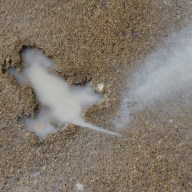Take a wild guess whether heating your house this winter will leave a large ecological footprint.
You may have a good idea already, but if you’ve got doors with no weatherstripping, windows with cracked or absent caulking, drafts blowing in, or windows and walls that exude cold, you’ve probably got a monster footprint. An older inefficient furnace can waste a ton of energy, and large icicles hanging from the roof in the winter can also indicate that heat is escaping in a major way. Another way you can tell is if you’ve got a heating bill much higher than similar neighbouring houses.
Leaving a large ecological footprint when you heat your home means that you are heating your house inefficiently.
Yes, we most certainly need to heat our homes in this climate, and this effort will always leave a “footprint.” But the issue is not whether we leave a footprint — we will — but how small and light we can make that footprint.
To shrink your footprint, one of the first things you can do is to schedule an audit of your house.
If you’re in Ontario, check out homeenergyontario.ca to find an auditor in your area. In other provinces, google energy rebates in your province to find information from the appropriate government department, and the government of Canada to find federal energy rebate information.
Auditors look at your home and provide you with a list of what you can do to make your home heating more efficient. The great thing is that you can get back half the cost of an audit in Ontario, and up to $10,000 in both provincial and federal rebates for applicable work.
Other ways to make your heating more energy-efficient include using a programmable thermostat.
The advantage of programmable thermostats is that you can heat the house more when you are at home. Also remember that most people sleep more comfortably in cooler temperatures, so it makes sense to turn it down at night to about 18 degrees Celsius, and set it to run higher (say, about 22 degrees Celsius) just before you get up out of bed.
Last but not least, remember to change furnace filters according to the scheduled published by the manufacturer. It makes a difference.
















